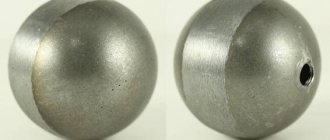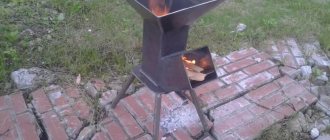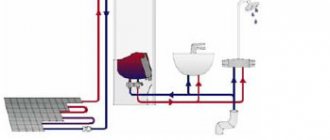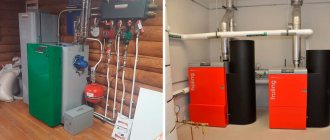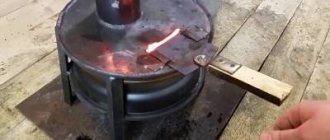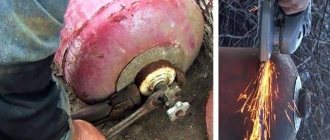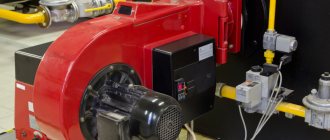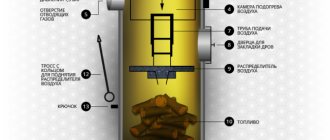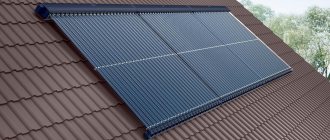The popularity of used oil as a source of calories in heating systems is explained by its low cost. Before the era of energy crises, car companies spent money on recycling it. With the advent of heating devices that have automatic boilers for waste oil, it became advisable to burn it, obtaining heat and carbon dioxide needed by plants as the end products of hydrocarbon oxidation, as well as nitrogenous compounds in the form of impurities.
Automation for waste oil boilers is gaining popularity.
Types of burners and their design
Oil combustion is classified according to 2 types of fuel entering the working chamber:
- drip method (under the influence of gravity by gravity);
- building up pressure.
The first type is used in homemade heat generators for small areas. It is considered a fire hazard and resource-intensive. The oil drips by gravity from a container located above in portions onto a hot bowl, where it burns, releasing calories.
In modern designs, the preparation of a suspension of oil with an oxidizer is carried out using the second method by injection of air.
The burner consists of the following parts and components:
- liquid fuel tank;
- oil pump;
- exhaust filtration system to remove solid and non-combustible fractions;
- nozzle;
- mechanism for dosed oxygen supply to form a torch;
- fuel pipelines;
- exhaust gas ducts.
The burner consists of various parts.
For initial ignition, devices have been developed to independently heat the oil to operating temperatures. The design ensures complete combustion of fuel. First, a low-pressure zone is formed in the nozzle area, where the heated oil enters and is converted into a cloudy mixture with the forced air. Next, ignition and complete combustion of the petroleum product occur.
Babington burner
The weak point of designs with forced fuel supply is the nozzle. To form an air-oil suspension, its working spray hole is drilled to 1.5 mm. During operation, it becomes clogged and requires cleaning.
In a Babington burner, oil flows down a spherical surface. Gradually, its layer thins to a film. Part of the fuel is converted into a cloud under the action of an air flow from an opening in the center of the unit, which ignites and forms a torch. Unburnt waste is collected by the storage tank and returned to the reservoir through a settling tank for reuse.
The difference between this design and others is that air is supplied under pressure through the nozzle, not fuel. Pre-filtration and removal of contaminants are not necessary. It is enough to increase the fluidity of the oil by initial heating.
Diagram of a Babington burner.
Drip type
It is possible to burn the waste without preheating and pressurizing, releasing it in doses into a hot cup evaporation burner. Fuel is supplied from a separately located container. The bowl works as part of a heating boiler or heat generator. This device is not used separately, unlike true burners that can be installed in heating units of different configurations.
For liquid fuel
Mobile and productive devices include a pyrolysis burner. Oil consists of hydrocarbons, which, when burned at room temperature, are not completely oxidized, releasing a small number of calories and a large amount of soot. Therefore, it is heated to degrees when the fuel splits into fractions.
When a container with a portion of fuel is set on fire, light components of the oils begin to evaporate from the surface and evaporate into the afterburner chamber. There they burn to colorless carbon dioxide and small soot fragments, releasing heat.
Advantages of this method:
- compact design;
- economical fuel combustion;
- environmentally friendly process safety.
The pyrolysis burner is a mobile device.
The disadvantages include the complex design of the initial ignition of the working composition, when it is necessary to heat a large mass of fuel.
Supercharged injection
This type of burner is used to create a torch with a temperature of +1200…+1400°C. The adjustment is carried out by intensive air pumping (in the metallurgy of bottled oxygen), which reduces oil consumption and increases the performance of the unit.
The disadvantages include:
- complexity of manufacturing and fitting parts;
- the need for fuel filtration;
- mandatory installation of automation.
The design is energy-dependent and consumes 20-25 W to produce 1 kW of heat.
Fuel supply to the burner
This was one of the most difficult problems - to provide a droplet supply of fuel. The burner itself is not sensitive to solid impurities in the oil, but the drip mechanism is very sensitive. The problem was solved like this. I installed an oil filter from a car at the lower end of the intake hose, which provides complete filtration (there are filters with partial filtration, but they are not suitable for us). The filter has a metric thread. I was unable to find a suitable pipe to screw the filter onto. But I took a fitting of a suitable diameter, put a piece of oil-resistant rubber hose on it and simply pushed it tightly into the filter hole. The filter must be changed regularly, once a month.
Here is a selection of materials:
Everything you need to know about heating and climate control Features of the selection and maintenance of boilers and burners. Comparison of fuels (gas, diesel, oil, coal, wood, electricity). Do-it-yourself ovens. Coolant, radiators, pipes, heated floors, circulation pumps. Chimney cleaning. Conditioning
As an oil pump I use a high pressure fuel pump from an injection Volga GAZ 3102-40I. It is a bit difficult for it to rotate with oil inside, but this is compensated by the fact that there is practically no excess pressure at the outlet. The injector output is more than 3 atmospheres. In general, during testing the pump performed excellently. It has only one drawback, it is too productive. But this was easily dealt with. The solution is shown in the diagram. A structure is assembled from two half-inch tees, three fittings, a nipple and a piece of a pin (adjustment rod).
Now the pump pumps exactly as much oil as can be placed in the structure, taking into account the location of the rod in it, until the return flow comes out. All the rest of the oil flows back.
The lower fitting is fitted with a piece of medical dropper with a clamp for adjusting the dripping speed. Oil drips from it into an open funnel. The dripping speed must be adjusted so that the burner burns steadily, but does not smoke. The less oil, the better the combustion, but the flame may begin to go out. The adjustment depends on the viscosity, temperature and properties of the fuel. So if the fuel changes, a new adjustment is required. The oil should be at room temperature (10 - 20 degrees), otherwise it will not drip.
The tube loop in front of the burner is filled with oil and forms a hydraulic lock that prevents air from escaping from the compressor through this pipe. The funnel into which the oil is dripping must be open to prevent the pressure in the burner from influencing the dripping rate. The funnel should be at such a height that the oil level stabilizes at the very bottom of the funnel when the air compressor is turned on and there is no exhaust flow. I made the funnel from an empty plastic drinking water bottle. I cut off the bottom and glued a fitting into the neck. Just glue the fitting with oil-resistant glue. I first glued it in place. The moment instantly dissolved from the oil. For example, Poxypol will do.
Advantages of burners during mining
Advantages of using such structures:
- absence of rubbing parts of the working area and the impossibility of their mechanical wear;
- ease of manufacture in home workshops;
- information accessibility (there are many drawings and manufacturing instructions on the Internet);
- cheap fuel;
- energy productivity of oil as a source of calories;
- compactness of the working part of the device, allowing the burners to be built into heating systems that were installed previously;
- developed fire safety measures.
The impossibility of mechanical wear is an advantage of the burners.
The use of these devices improves the environmental situation in the country.
Additional Tips
When using a homemade burner, there are usually increased requirements for compliance with fire safety rules
Important to remember:
- Do not leave a working nozzle unattended.
- It is prohibited to install the equipment in a residential area.
- To heat the heating main boiler, a special room is usually made without flammable coating on the walls, ceiling and floor.
- To increase operating efficiency, heavily contaminated waste is enriched with clean oil.
- Reliable ventilation is built in the boiler room to remove gases and smoke after fuel combustion.
- Carry out regular maintenance and equipment reliability checks.
If used correctly, a homemade burner will last for many years. The savings from using this type of heating are obvious, because the used oil has already been paid for, and if not for the homemade firebox, it would have to be disposed of.
Operating principle of a waste oil burner
From a scientific point of view, oil is a mixture of unsaturated hydrocarbons. At room temperature, it does not burn completely, and the energy stored in it remains in the form of chemical bonds.
For complete fuel utilization, the following conditions are created:
- initial heating to the sublimation temperature of liquid fractions;
- mixing with oxygen contained in the air;
- transient combustion of the formed dispersed cloud;
- utilization of heat released as a result of the oxidation of petroleum products;
- removal of formed carbon dioxide and impurities from the working area.
The principle of operation of a waste oil boiler.
A range of industrial petroleum products and vegetable oils are used as fuel. The higher the viscosity of the fuel, the greater its energy saturation and the more difficult it is to convert it into air suspension.
Fuel preparation
Oil after draining from engines contains debris in the form of metal impurities. During storage and transportation, it mixes with flammable and non-flammable liquids and needs to be cleaned from foreign fractions. Therefore, it is filtered in the fuel line before being supplied to the combustion sections.
Dirty viscous oil soon damages filters by clogging them with impurities. This problem is solved by stepwise cleaning. In the tank, metal impurities are separated mechanically, passing through a fine mesh. Fine cleaning is carried out first, reducing the viscosity of the oil by heating to +100...+200°C or using heating elements. It is possible to run the oil line through heated structural parts.
Oil supply to the burner
The automatic design power supply uses forced fuel supply. It is provided by an oil pump, which creates pressure in the line. The heated waste is fed to the nozzle and forms a fine suspension, which forms a torch. Unburnt drops condense and are discharged through the return channel into the fuel tank. The synchronization of multi-time processes is ensured by the automatic design of the boiler, which regulates the flow of fuel and air.
Lighting and maintaining the fire
The fuel must burn at a temperature of +190…+200°C.
Ignition and maintenance of fire occurs at high temperature.
To achieve this indicator, systems are installed:
- preheating device up to +80…+90°С;
- a mechanism for saturating the mixture with excess oxygen using a turbine or fan;
- electric ignition in the form of electrodes that ignite a fine cloud in automatic mode;
- secondary air supply fan to maintain combustion in productive mode.
The specified set of accessories is installed when the burner is fully equipped.
Preparing waste for combustion in a boiler
Spent liquid fuel is not only contaminated, but also quite sticky. This is due to the fact that special additives are added to the initial composition to ensure tight adhesion of a thin layer on the rubbing surfaces. Therefore, these burner devices must operate with mandatory heating of the exhaust to increase fluidity. Since viscous fuel is not able to mix well with air and will not be able to pass through the nozzle nozzle.
The next element that should be in the design of the burner device is a reliable ignition system for the gas-air environment. In practice, only an electric spark or a gas torch can ignite such an energy carrier.
And the last important design decision is the presence of systems for preliminary coarse and fine purification of used oil. Before entering the burner device, the waste must undergo filtration, first with coarse cleaning, where large debris is removed from it, and then fine, after which fine suspended substances, such as sand and clay, are eliminated.
How to choose a burner for mining
When choosing this boiler module, the determining factor is power. The fuel preheating mechanism and injector design are important.
Power
It determines the performance characteristics of the burner. Installing a 30 kW device in a 15 kW boiler is unacceptable and will lead to melting of the structure. The data sheets of store products indicate the heat transfer and the dimensions of the recommended and maximum heated areas.
Number of steps
Heat transfer power is regulated in 2 ways:
- Single-stage burners heat the coolant to a given temperature. Next, the fuel supply is blocked, the boiler cools down to the set value, and the cycle repeats.
- Two-stage designs operate without shutting down in 2 modes: at full power - when the system warms up to the planned levels (after which it begins switching to economical oil consumption), half or two-thirds less.
Power control is carried out by the burner.
This method of adjustment requires equipment with automation, which increases the cost of the design, but reduces operating costs by 15-20%.
If the supply of fuel and air is fully automated and is guided by the readings of temperature sensors of the coolant, heated and burned oil, the volume of incoming air and fuel, then such units are called smooth two-stage and modulating.
Size and volume
The burners are compact, their performance does not directly depend on the size of the heating devices and is determined by design solutions at the planning stage.
Burner material
Its body is made of corrosion-resistant steel parts, fuel lines are made of soft non-ferrous metals (copper) and their alloys.
Oil consumption
The amount of fuel for heating the room depends on:
- heat loss of serviced areas;
- territorial affiliation with climatic zones (in the Arctic region winter is colder and longer);
- the amount of impurities and their effect on the caloric content of the combustible mixture;
- unit efficiency;
- settings of the heating device and its power;
- number of working hours and temperature conditions of the heated room.
Oil consumption depends on the heat loss of the serviced areas.
The approximate figure for the middle zone of the country is 2.5-4 tons with a round-the-clock consumption of 3 liters per hour.
Smoked meat with spicy marinade
Sometimes it makes more sense to marinate meat than to salt it. True lovers of smoked delicacies are against this method, because they prefer to enjoy the natural taste and smell of meat products. We will not argue about tastes, we will only note that there are also many lovers of savory snacks with admixtures of peppers and other spices. Marination exists as a method of preparing meat, and it cannot be ignored.
The brine must be prepared hot. We will present a step-by-step algorithm for obtaining the marinade. You will need to prepare salt, ground black pepper, allspice, bay leaf, thyme, garlic. Nowadays it is possible to use ready-made seasonings for salting meat, but by adding all the ingredients yourself, you can control their quantity in the marinade.
Of all the above, only salt is added strictly in a certain proportion. The remaining components are added solely at the request of the cook. For hot smoking, you need to take 50 grams of salt per liter of water, and for cold smoking - 70 grams. This difference is explained by the fact that high temperature provides additional protection against microorganisms, and also softens the meat by transforming fibers. When cold smoking, all hope is for a sufficient amount of salt.
A solution of salt and water is heated to a boil, then all other ingredients are added to it. Do not overuse too many spices. There are tastes and smells that go well together, but there are also those that should not be found in the same dish. If you don’t have subtle taste or are not confident in your knowledge, then you shouldn’t take risks. The simplest combination is salt, pepper, garlic, mustard. After 10-15 minutes of boiling, the marinade should be cooled.
Pieces of meat are immersed in the chilled marinade so that they are completely hidden. Semi-finished products are placed in the refrigerator for 3 days. After the specified period, the meat is taken out of the vessel and dipped in red pepper. The last manipulation for spicy lovers. If there is no such desire, then you can simply dry the pieces so that they are sent dry for smoking, even with a thin film.
Using a waste oil burner
Proper operation of the device improves the financial condition of the owner and the life of the unit. It is necessary to ensure its safe use and timely repair.
Instructions
The operating mode of the burner involves temperature changes, which leads to a decrease in the clearance of the fuel lines and a deterioration in the degree of fuel combustion. To increase the operational life of the burner during testing, they draw up a preventive and service plan, shown in the instructions.
Before the operating season the following is carried out:
- setting the combustion mode of petroleum products;
- identification and replacement of worn parts;
- cleaning or changing filter elements;
- analysis of combustion products.
Before the operating season, the combustion mode is adjusted.
For objective assessment, instruments are used: pressure gauge, gas analyzer, soot measurement test.
At the beginning of the heating season, instructions are posted with the daily maintenance schedule for the burner and the frequency of cleaning it from soot.
Safety precautions
To prevent fires and other troubles when operating fuel-burning appliances, follow the following rules:
- the area of contact with the burner is arranged: the walls and ceiling are covered with metal with asbestos lining and the access of unauthorized persons and bystanders is limited;
- the fuel tank is placed at a safe distance;
- when leaks are detected, the flow of flammable materials is blocked;
- the structure is electrically insulated to avoid sparking in the oil spray area;
- The heating unit is located in places that prevent the formation of drafts and air turbulence.
An operating burner must be under the supervision of a designated person.
Trouble-shooting
There are no moving parts in the fuel combustion mechanism. Malfunctions are only possible due to the accumulation of soot, which is removed by routine cleaning. Electrical appliances (fan, oil pump drive, heating elements) are repaired or replaced with working copies.
Malfunctions occur due to soot accumulation.
Industrial burners in production and their features
Structures that provide space heating and are produced industrially are characterized by pre-declared properties of the heat flow produced.
When selecting a factory burner for testing, its parameters are taken into account:
- the power of the device stated in the passport (it must exceed the performance of the heating unit);
- number of stages and features of switching combustion modes;
- complete set of air and fuel supply devices;
- possibility of installing heat generators on the planned boiler.
Additionally, pay attention to the thickness of the boiler body and door to correctly select the size of the nozzle and flame atomizer, which should be thicker.
When purchasing, they take into account that factory-made products are obviously more expensive; they are modernized according to the rules and within the corridor pre-established by the manufacturer.
General view of the finished structure
When the burner is set correctly, there should be no smoke. The only thing coming out is hot, wavy air.
There is an oil pump under the burner. Its task is to suck oil from the tank, where the oil settles, which passes around the propane cylinder twice (at the same time heating up), exits the door handle and, as a result, is sprayed.
Please note: in this installation there is no regulation of the propane supply, since it is quite inconvenient to control it with the cylinder handle alone, however, automation can be installed on everything.
Also, to make the design easier to understand, there is no fuel tank; the suspension is immediately poured into the sump. There are various drawings of these burners, but now we are considering the simplest option.
Advantages of this type of burner:
- It is quite easy to make without any help.
- cheap way to generate heat.
- An effective and functional device, it is lightweight, which makes the design mobile.
Quality burner brands
It is believed that North American manufacturers (USA and Canada) provide unrivaled quality and reliability. Their products are installed on industrial space heaters. Among European companies, German and Austrian companies are popular due to their traditional production culture. Chinese, Korean and Polish products are replicas of industrial burners for utility rooms in the household. They are distinguished by their affordability and versatility.
Nortec
The Chinese leader in climate control equipment offers budget universal burners of the WB series. Heat sources include animal fats, heating oil, waste vegetable and automobile oils, and diesel fuel. To reconfigure the system when changing the type of hydrocarbons used, it is enough to adjust the air supply mechanism manually.
Nortec is a universal burner.
Features of using universal Nortec burners:
- The use of gasoline, solvent, and substances that form explosive mixtures when heated is prohibited;
- to facilitate starting and ensure the stated operating mode, the oils should be diluted with diesel fuel in a ratio of 10:1;
- It is not recommended to burn fresh, unused petroleum products.
Products are certified.
Euronord
The Chinese manufacturer produces Euronord burners for installation on stationary and mobile heat generators and water heating furnaces for indoor spaces. They are equipped with compressor and fan equipment for supplying oil and air. The range of models is represented by a single-stage combustion type from 16 to 230 kW.
Advantages of the company's products:
- preliminary fuel purification is carried out in a filtration segment, which is more successful than a filter similar to a car one;
- the air line passes through the oil heating chamber, which improves the degree of combustion of the components;
- fuel heating is two-level.
The manufacturer sells products with safety and quality certificates.
Euronord EcoLogic
Euronord Ecological burners are adapted for heating structures of global manufacturers thanks to a unitary seat, which facilitates installation and maintenance work.
Euronord EcoLogic – burner for heating structures.
Operating mechanisms and functional parts are accessible without removing the entire unit.
Electronics, control unit and electrics from European manufacturers of German Siemens and Italian Fida levels.
DanVex
The Finnish concern DanV ex Oy (Osakeyhtio) offers Russian consumers ready-to-install fan-compressor burners complete with compressors of its own production. DanVex liquid fuel appliances are designed to operate on the company’s heating units, but can be integrated into designs from third-party manufacturers if the technical specifications and flange sizes match.
Olympia
The Russian company offers consumers waste oil burners of the AL model range. For domestic needs, a single-stage AL-4V device with a power of 15 to 45 kW is used. The package includes a floating fuel intake with a pump and filter on a bracket. Oxygen is pumped by an air compressor with a pressure of 2 bar. The burner is equipped with a continuous purge system to prevent parts from melting when it stops. All types of waste and their mixtures are suitable. The burner is installed on various types of liquid fuel boilers and thermogenerators.
Olympia – waste oil burner.
"Stavpech"
The boiler plant in Stavropol produces heating appliances under the Stavpech brand: boilers, air heaters, components and automation at an affordable price. It also produces “Gnome” burners with a power from 10 to 35 kW.
Its features:
- fuel is supplied to the combustion chamber by compressed air from a compressor;
- the oil is heated by heating elements in the fuel tank and a heater in the nozzle;
- the supply of primary air is regulated by a reducer, secondary - by a fan;
- Mineral and synthetic oils of industrial origin and vegetable rapeseed oil, animal fats and their mixtures of arbitrary dosage are burned.
The burner is universal and works on water heating equipment and heat generators from other manufacturers.
Differences between glossy, satin and matte ceilings
Each group of canvases for suspended ceilings is divided into the following groups:
- PVC is a thin film made from polyvinyl chloride.
- Fabric is a material of synthetic origin that is made from polyester.
Glossy
The texture of the glossy PVC film is completely smooth. The varnish surface is capable of reflecting every decorative element like a mirror, which visually helps to increase the space and creates the effect of luxury. Such ceilings are universal, as they will look great in both classic and avant-garde interiors. But such a surface sometimes has a negative effect on people’s psyche.
Matte
Matte type canvases have a rough texture
PVC film will not reflect light, and therefore the ceiling does not attract much attention. White surfaces will visually strongly resemble plaster
Although there is an opinion that such ceilings look too ordinary, if you use decorative elements like ceiling plinths, built-in lamps, stucco moldings and other things, this drawback can be quickly eliminated.
Satin
Stretch ceilings - matte, glossy, satin - have one common quality, namely that they are all made of PVC film. The surface of satin is reminiscent of matte canvases, but still has special qualities. First of all, they include appearance, namely, that satin is something between glossy and matte fabric. The surface of the film has a practically smooth, fine-grained texture. They are produced in different shades, but the palette is still more modest compared to glossy-type analogues, but at the same time brighter than that of matte films.
Please note that only satin ceilings have a pearlescent tint and soft reflection of light. Artificial lighting will be diffused throughout the room and the color will change depending on the viewing angle
Fabric
Such ceilings are a synthetic fabric made of polyester threads impregnated with polyurethane. The texture is only matte. The texture resembles fabric, and the material is available in about 20 shades, most often pastel. The main difference from PVC films is that after installation the canvas can be painted. In addition to appearance, there are many other differences.
| Peculiarity | Glossy | Matte | Satin | Fabric |
| Reflection of light | Mirror effect | __ | Pearlescent shine, soft diffused light | __ |
| Moisture resistance | Stable | Stable | Stable | Not stable |
| Palette | A large number of rich and bright colors, photo printing is possible | Large range of colors, photo printing available | Large selection of pastel shades, including pearl and metallic | Small selection of shades, can be printed and painted |
| Nuances of care | The surface is smooth, easy to wash and clean | The surface is rough, resistant to frequent washing, and does not leave streaks. | The surface is smooth, dirt and dust do not accumulate on it, dirt can be easily removed | The texture is rough, dirt and dust accumulate on it, which are difficult to remove; cleaning with special means is required |
| Maximum width | 320 cm | 320 cm | 270 cm | 510 cm |
| Permissible room temperature range | From +5 degrees to +50 (if the temperature is higher, the material will begin to crack and deform) | Can be used at any ambient temperature, even in unheated cold rooms | ||
| Minimum service life | 10 years | 10 years | 10 years | 15 years |
DIY waste oil burner
It is recommended that a home craftsman master the manufacture of a heating device if there is a need to heat non-residential premises. The Babington burner, equipped with forced air, is best suited for this purpose. It is capable of processing diesel fuel, fuel oil, kerosene, and vegetable oils.
When changing the heat source, it is enough to change the diameter of the nozzle and adjust the intensity of the air supply into the combustion chamber. The design features make it indifferent to the quality of the working mixture. The fuel may be contaminated with water and metallic inclusions (sawdust).
Preparation and tools
During the preparatory period, materials are sought:
- sheet metal for the heater body and structural parts;
- copper and steel tubes for fuel and air (DN10);
- oil reservoir and sump;
- sanitary tee d=50 mm;
- an oil supercharger (preferably an automobile one) with an engine for it (speed control is required);
- a sphere or hemisphere-evaporator less than 40-45 mm, placed inside the tee;
- Heating element for warming up the oil before starting;
- valves;
- bolts, nuts, fasteners.
The DIYer needs sheet metal for the body.
Tools:
- converter (welding);
- angle grinder (USHRM);
- hacksaw for metal;
- metalworking tools (vises, files, etc.).
Drawing development
Before manufacturing the unit, the burner structure is tied to the place of its operation.
Working diagrams and drawings define the details of the heating system:
- device dimensions;
- heat exchanger design (air or water heating);
- ease of access to the working area of the device for routine cleaning of the combustion chamber;
- method of fuel supply (forced or natural gravity), return collection and, based on this, placement and type of oil container;
- an oxygen supply system for the utilization of unsaturated hydrocarbons into gaseous combustion products.
Drawing of a waste oil boiler.
Assembly
Possible design of the heating device and the sequence of manufacturing steps:
- weld the boiler body from sheet metal or use cylindrical parts and blanks (propane or oxygen cylinders);
- prepare a seat for the burner;
- supply air and fuel;
- a mechanism for initial heating of the oil to 80°C is installed in the lower part of the boiler.
Burner assembly:
- A spray hole d = 0.1-0.3 mm is drilled in the hemisphere for direct fuel supply, or a unit is assembled with a separately manufactured nozzle. The axis must coincide with the center of the duct to create a uniform spray.
- The hemisphere is fixed inside the tee, in the upper part of which a fitting for supplying oil will be welded, and in the lower part there will be pipes for collecting unburned fuel.
- The nozzle is made from a muffled squeegee 10 cm long.
- The air duct is equipped with a compressor to create a pressure inside the combustion chamber of at least 5 bar.
- A copper pipe fuel line is wrapped around the burner 3-5 times to heat the oil.
An oil heating mechanism is installed at the bottom of the boiler.
Airflow adjustment
The oxygen in the combustion chamber is called primary. It ensures oil combustion and the creation of reduced pressure for fuel supply. To ensure complete combustion of the petroleum product, secondary air is pumped into the apparatus using a fan, the flow of which is controlled by a damper and by changing the speed of the electric motor. In an experienced way, automatic changes in operation are achieved so that the motor provides the amount of oxygen depending on the degree of its opening.
Fuel supply to the burner
The oil supply system for the device must be grounded, sealed and not clogged during the manufacturing process. The amount of supplied air and fuel must be balanced and ensure complete combustion of petroleum products; pressure electrical appliances - have parameters corresponding to the design power of the burner. It is recommended to take the oil with a fuel receiver on the float, while preventing mechanical impurities that settle at the bottom of the container from entering the system. Before combustion, the fuel is heated to a temperature of +100…+800°C.
Completion of production
The burner will have a powerful flame, but for smooth operation it is important that all designs of external elements are thought out correctly. In the considered option, the waste flows down the sprayer in the shape of a sphere, but most of it returns back to the tank, a small amount ends up in the nozzle
To increase efficiency, it is recommended to install at least a weak heating element in the main tank. If you do not want to manually pour oil from one tank to another, you need to install a small pump. It is installed between the tanks and allows oil to be pumped from one to another, thereby ensuring circulation.
To increase the service life of the unit, it is recommended to treat the connections with high-temperature sealants. It is recommended to install a thermostat on the heating element (if one is not provided). It is enough to warm the oil to a temperature of 70 degrees, there is no point in doing more. The end result should be three nodes consuming power. These include:
- Compressor.
- Oil pump.
- A heating element.
Unfortunately, it is not possible to make a completely energy-independent design, since it is not recommended to exclude a heating element or an oil pump. As for the compressor, without it the burner will not work at all. But you still save a lot on fuel - used oil costs pennies.
DIY nozzle
The blank parts can be a metal furniture handle or a hemispherical nut. It is allowed to use a curved metal plate with a welded nozzle.
The nozzle extending into the hole of the hemisphere provides air supply to the burner. The power depends on the quality of its manufacture and the calibration of the hole. It is mounted flush with the hemisphere. It is recommended to use industrial jets (automotive; for gas equipment).
The recommended hole diameter is 0.3-0.35 mm, it provides 17-18 kW of heat. Increasing the size causes flow turbulence and deterioration of process performance. If there is a need for more heat, increase the number of holes, placing them no closer than 1 cm from each other.
You can also make a mining boiler with your own hands.
Assembly and commissioning
The bodies of such boilers consist of two pipes inserted into each other, the radius of which should differ from each other by 30–40 mm. The external part must be equipped with 2 outlets - for direct and reverse supply of coolant. And inside the smaller-diameter pipe is a combustion chamber. The waste container is located next to the boiler - a pump is immersed in it to supply fuel to the pyrolysis chamber.
The further installation process includes the following steps:
- Placing another container for oil at the bottom, with the creation of holes in it for gas vapor to enter the chamber for secondary combustion;
- Conducting contacts for electrical ignition of the burner through the combustion door;
- Inserting a fitting, thanks to which a gas-air mixture is formed, into the chamber wall;
- Creation of a chimney with a slide damper to remove combustion products, which the diagram provides;
- Placement of a gas outlet tube lowered to the level of the bowl with oil;
- Installation of a circulation pump on the return line, and safety groups on the direct line.
Before starting to operate the equipment, check the degree of sealing of the seams by filling the appropriate containers with oil and water. It is recommended to carry out the first launch by pouring only a 10 mm layer of oil purified from mechanical impurities with the addition of 100 ml of kerosene. The waste is ignited using a wick dipped in lighter fluid and lowered to the bottom of the container.
